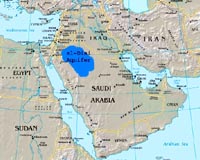| . |  |
. |
Sydney (AFP) Dec 3, 2009 The rotting carcasses of thousands of wild camels who have died of thirst in Australia's desert Outback are polluting vital waterholes and sacred sites, a report said Thursday. The Central Land Council, which administers Aboriginal land in the nation's arid centre, said the corpses were poisoning water supplies, describing scenes of mass carnage. "Some fall into waterholes and won't be able to get out so they'll rot within the water, others will chase the last remains of any water in these areas and start to compete with each other," the council's land management chief David Alexander told public broadcaster ABC. "We're ending up with these grisly scenes of camels in every stage of life, death and decay around waterholes," he said. Thousands of pools, creeks and other water supplies for local indigenous tribes were rendered undrinkable by the decay, with a "significant health risk" when they are refilled by rain, he said. Without significant rainfall, Alexander said tens of thousands more camels in the drought-gripped region faced a similar fate, with dire environmental and cultural consequences. "It has the capacity to change the flow of water, it changes the character of these places and some of the specific features around them have their own cultural significance, they have stories associated with them, ceremonial songs," he said. Native animals were also perishing as a result of the mass deaths, with "massive" impacts on biodiversity, he said. Meanwhile officials are preparing for an aerial cull of 3,000 of the humped pests near the remote Northern Territory community of Docker River with helicopters and snipers. Protracted drought drew the camels into the township in search of water, leaving some residents cowering in their homes as they smashed through water mains and invaded the airstrip. The herd, just a fraction of the one million wild camels estimated to be roaming Australia's vast central desert, would be mustered to a location well outside the township, shot and left to rot, Alexander said. Aboriginal elders would accompany the snipers to advise a spot to gun the animals down that was a sufficient distance from water supplies and culturally sacred spots, he added. Camels were introduced into Australia as pack animals for the vast outback in the late 19th and early 20th centuries, but were released into the wild as rail and road travel became more widespread. With few natural predators and vast sparsely-populated areas in which to roam, the population has soared, putting pressure on native species by reducing food sources, destroying habitat and spreading disease. Central Australia's camels are believed to be the largest wild herd on earth.
Share This Article With Planet Earth
Related Links Water News - Science, Technology and Politics
 Turkey's Gul urges more investment in Jordan's water sector
Turkey's Gul urges more investment in Jordan's water sectorQastal, Jordan (AFP) Dec 2, 2009 Turkish President Abdullah Gul on Wednesday urged his country's businessmen to invest in Jordan's water sector as he opened offices for a huge Turkish-managed scheme to supply Amman with water. "Turkish businessmen should increase their investments and cooperation with Jordan in the water field," Gul said as he inaugurated the headquarters for the Disi water plan, which is being carried out ... read more |
|
| The content herein, unless otherwise known to be public domain, are Copyright 1995-2009 - SpaceDaily. AFP and UPI Wire Stories are copyright Agence France-Presse and United Press International. ESA Portal Reports are copyright European Space Agency. All NASA sourced material is public domain. Additional copyrights may apply in whole or part to other bona fide parties. Advertising does not imply endorsement,agreement or approval of any opinions, statements or information provided by SpaceDaily on any Web page published or hosted by SpaceDaily. Privacy Statement |